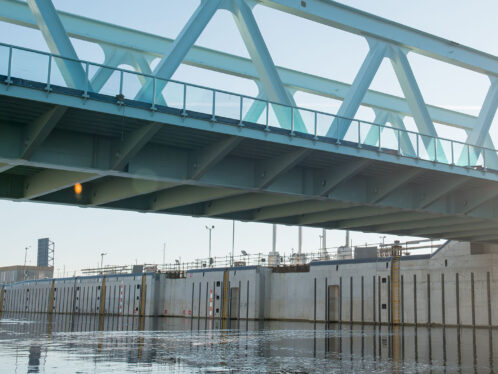
Bobcat on the job
Whether they’re working on hard ground or wet grass, Bobcat Compact Track Loaders get the job done. Their secret: rubber tracks that let them either tread lightly or dig in.
Summary
Bobcat, a global leader in compact construction and maintenance vehicles, teamed up with SKF to produce a tough, reliable breed of cat: the Bobcat Compact Track Loader.
Muscular and hard-working, these track loaders work in the worst conditions Mother Nature can throw at them. The punishment they endure would wear and eventually halt the tracks – if it weren’t for savvy engineering.
SKF did its part by supplying the Explorer performance class sealed spherical roller bearings.
“A series of bearings are mounted inside the track mechanism,” explains SKF Account Manager Mark Hinckley. “Their job is to keep the tracks moving freely.
“Each bearing is equipped with seals that perform double duty. They add a layer of protection, shielding the bearings from soil and other contaminants. And they seal in a lubricant that keeps each bearing turning smoothly.”
“SKF worked closely with us in developing the bearing system,” says Bobcat Product Representative Michael Fitzgerald. “As a result, track-loader owners and operators can be confident they’ll get the job done.”
Bobcat. The word conjures up images of a tough and compact wildcat. In much of the world, it also summons images of compact construction and maintenance vehicles – the diesel-powered Bobcats that clear land, dig trenches, haul scoops of earth and sand, break up concrete and level the soil at construction sites.
These machines, with their telltale orange, white and grey colour scheme, have made a niche for themselves. They can work in severely confined spaces such as narrow strips of urban land and the tight quarters found in factory yards – something their cousins, the bulldozers, backhoes and trenchers, can’t do. And since time is money, Bobcat customers rely on their machines to keep working.
“Unscheduled downtime is very expensive for our customers,” stresses Bobcat Product Representative Michael Fitzgerald. “Contractors, for example, may earn bonuses for finishing jobs on time or early.”
Other problems, such as adverse weather and soft ground, can bog down or halt wheeled machines. Bobcat designers and engineers attacked these work stoppers by developing Bobcat Compact Track Loaders – machines that move on rubber tracks.
“Because these machines are smaller and lighter, they give our customers a big edge, in certain conditions, over traditional, heavier and larger equipment,” explains Fitzgerald. “The tracks distribute the machine’s weight over a larger area than wheels could. That means track loaders essentially float over wet and muddy ground. They tread lightly on the land. That reduces the amount of site reclamation after a job and saves their owners time and money.
“On the other hand, the tracks give track loaders a powerful grip on the surface,” he continues. “The traction provided by these machines far exceeds that of normal loaders. The bottom line is that our customers can rely on them to keep on working, digging or hauling soil or other material.”
Toughness built in
A subsidiary of Ingersoll Rand and one of the worldwide market leaders in compact equipment, Bobcat sells track loaders and other machines around the globe. Given the lynx-like toughness and manoeuvrability of the company’s products, it’s fitting that the Bobcat Company itself is based in West Fargo, North Dakota, about 320 km south of the American-Canadian border.
This is a place where winters are fierce, winds are unforgiving and snow stays on the ground for six months at a time. It’s a home that calls for the hardiness and resourcefulness of the bobcat.
The company itself began as the Melroe Manufacturing Company, founded in 1947 by Edward Gideon “EG” Melroe, the son of Norwegian immigrants. Situated in Gwinner, North Dakota, the company met an increasing demand for grain-harvesting attachments and other farm equipment. A big success came when the company developed a three-wheel “loader” powered by a 4.5 kilowatt engine with a rope starter.
This was followed in 1960 by a wheel-driven skid-steer loader. In 1962, the company adopted the Bobcat name and logotype. In 1965, it began marketing its machines in Europe. During the following decades, it kept improving its products and adding to its line of machines.
Today, the company operates plants in Gwinner and Bismark, North Dakota, in Grove City, Minnesota, and in France and the Czech Republic. It sells its products through a network of 900 dealers in 75 countries. Those products include a line of compact machines that run on 12 to 75 kilowatt diesel engines.
These machines include skid-steer loaders, mini excavators, loader backhoes (with a scoop in front and a backhoe mounted at the rear), and even smaller, seatless, walk-behind loaders. Also in the product line is a utility vehicle that amounts to a mini truck and the Bobcat VersaHandler TTC (Telescopic Tool Carrier) – a multipurpose machine equipped with a loading bucket on an extendable arm.
The company also manufactures attachments for its machines – augers, landscape rakes, backhoes, trenchers, brooms and hydraulic tools that break down walls and break up asphalt, concrete and hard clay ground.
“Our machines’ talent for working in tight spaces gives us our biggest niche,” notes Bobcat Design Engineer Jeret Hoesel. “Some of them are used on farms and dairies. Others work in mines. But most of our machines are used in construction and industrial plants, where work areas are confined and larger construction equipment can’t manoeuvre.
They work in facilities such as recycling plants, steel mills and sawmills and on asphalt and concrete projects where space is at a premium. Landscaping and general construction in confined areas keep our track loaders especially busy.”
On track
Bobcat Compact Trackloaders come in three models – T190, T200 and T300 – with carrying capacities ranging from 860 to 1,360 kilogram. The tracks are made of rubber rather than steel on all models.
The operator works the controls and the machine goes to work on the moist, bare soil. Instead of scarring the soil or sinking, the Bobcat moves smoothly along the soft surface.
“Our machines are used in a wide variety of applications, and the market for rubber tracked equipment is growing,” notes Fitzgerald. “Every day, customers see how reliable this equipment is, and how much more they can accomplish with it.”




